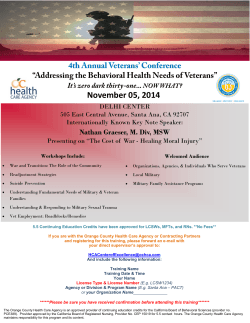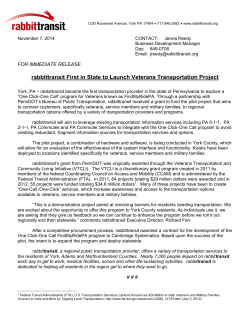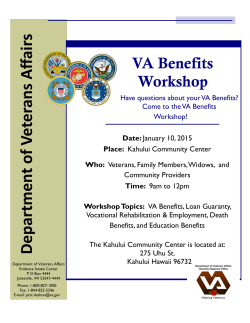
Higher Education Benefits for Post
C O R P O R AT I O N CHILDREN AND FAMILIES EDUCATION AND THE ARTS The RAND Corporation is a nonprofit institution that helps improve policy and decisionmaking through research and analysis. ENERGY AND ENVIRONMENT HEALTH AND HEALTH CARE INFRASTRUCTURE AND TRANSPORTATION This electronic document was made available from www.rand.org as a public service of the RAND Corporation. INTERNATIONAL AFFAIRS LAW AND BUSINESS Skip all front matter: Jump to Page 16 NATIONAL SECURITY POPULATION AND AGING PUBLIC SAFETY SCIENCE AND TECHNOLOGY TERRORISM AND HOMELAND SECURITY Support RAND Browse Reports & Bookstore Make a charitable contribution For More Information Visit RAND at www.rand.org Explore RAND Testimony View document details Testimonies RAND testimonies record testimony presented by RAND associates to federal, state, or local legislative committees; government-appointed commissions and panels; and private review and oversight bodies. Limited Electronic Distribution Rights This document and trademark(s) contained herein are protected by law as indicated in a notice appearing later in this work. This electronic representation of RAND intellectual property is provided for noncommercial use only. Unauthorized posting of RAND electronic documents to a non-RAND website is prohibited. RAND electronic documents are protected under copyright law. Permission is required from RAND to reproduce, or reuse in another form, any of our research documents for commercial use. For information on reprint and linking permissions, please see RAND Permissions. Testimony Higher Education Benefits for Post-9/11 Military Service Members and Veterans Gabriella C. Gonzalez, Laura L. Miller, Peter Buryk, Jennie W. Wenger RAND Office of External Affairs CT-428 March 2015 Statement for the record submitted before the House Veterans’ Affairs Committee, Subcommittee on Economic Opportunity on March 17, 2015 This product is part of the RAND Corporation testimony series. RAND testimonies record testimony presented by RAND associates to federal, state, or local legislative committees; government-appointed commissions and panels; and private review and oversight bodies. The RAND Corporation is a nonprofit research organization providing objective analysis and effective solutions that address the challenges facing the public and private sectors around the world. RAND’s publications do not necessarily reflect the opinions of its research clients and sponsors. R® is a registered trademark. C O R P O R AT I O N Published 2015 by the RAND Corporation 1776 Main Street, P.O. Box 2138, Santa Monica, CA 90407-2138 1200 South Hayes Street, Arlington, VA 22202-5050 4570 Fifth Avenue, Suite 600, Pittsburgh, PA 15213-2665 RAND URL: http://www.rand.org/ To order RAND documents or to obtain additional information, contact Distribution Services: Telephone: (310) 451-7002; Email: order@rand.org Gabriella C. Gonzalez, Laura L. Miller, Peter Buryk, Jennie W. Wenger1 The RAND Corporation Higher Education Benefits for Post-9/11 Military Service Members and Veterans2 Before the Committees on Veterans’ Affairs Subcommittee on Economic Opportunity House of Representatives March 17, 2015 The Post-9/11 Veterans Educational Assistance Act represented the largest expansion of veterans’ education benefits since their origin with the enactment of the Servicemen’s Readjustment Act of 1944. Modern bills reaffirm President Franklin D. Roosevelt’s declaration upon signing the original legislation that educational benefits are an integral way to support service members’ transition into civilian life and compensate them for the sacrifices made during 3 military service. Educational benefits have also historically helped to recruit and retain individuals for voluntary military service; service members consistently acknowledge the importance of education benefits in their enlistment decisions. For example, 62 percent of service members responding to the 1999 Active-Duty Survey selected education benefits as the primary reason for enlisting in the military4 and 74 percent of active-duty military and veterans responding to a 2014 survey indicated that “receipt of educational benefits” was either an “important” or “very important” reason for joining the military.5 The most popular and generous educational benefit available today is the Post-9/11 GI Bill, which took effect in August of 2009. With over 1 million users as of 2014, it significantly increased the higher-education benefits available to those who served on active duty in the U.S. armed forces after September 10, 2001. With over 2 million total post9/11–era veterans and planned military end strength reductions in the coming years, usage of the program will likely continue to grow both in participation and cost. It is therefore vital that military 1 The opinions and conclusions expressed in this statement for the record are the authors’ alone and should not be interpreted as representing those of RAND or any of the sponsors of its research. This product is part of the RAND Corporation testimony series. RAND testimonies record testimony presented by RAND associates to federal, state, or local legislative committees; government-appointed commissions and panels; and private review and oversight bodies. The RAND Corporation is a nonprofit research organization providing objective analysis and effective solutions that address the challenges facing the public and private sectors around the world. RAND’s publications do not necessarily reflect the opinions of its research clients and sponsors. 2 This testimony is available for free download at http://www.rand.org/pubs/testimonies/CT428.html. 3 Department of Veterans Affairs, 2013. 4 Buddin and Kapur, 2002. See Eighmey, 2006, for further discussion of the motivations behind military enlistment, including education benefits. See Kleykamp, 2006, for an analysis of the propensity to enlist in response to military education benefits. See Simon, Negrusa, and Warner, 2010, for an analysis of military recruit responsiveness to education benefit generosity. 5 Blue Star Families, 2014. 1 personnel and veterans understand and are able to access educational benefits in order to successfully reach their educational goals and earning potential. To inform today’s Subcommittee hearing on the Department of Veterans Affairs’ administration of its education programs, and the educational and training needs of our post-9/11 veterans, we present the following statement for the record that integrates key findings from relevant RAND research publications. First, we characterize the types of educational benefits available to veterans from federal sources. We then discuss the potential difficulties veterans could have in navigating and accessing these benefits, the challenges veterans face in completing college degrees, and how “non-traditional” students could serve as a benchmark to measure veterans’ educational progress. We conclude with recommendations for Congress on how to improve access to highereducation opportunities for the newest generation of veterans. Easing Veterans’ Transition Begins While They Are in Service. The post-9/11 generation of veterans enjoys many federally funded opportunities to support the pursuit of higher education, both during and after military service. The departments of Defense (DoD), Veterans Affairs (VA), and Education (ED) administer a variety of programs that provide educational assistance to active-duty and reserve component service members, both before and after their departure from the armed forces. These programs range from examinations that provide college credit for knowledge and experience gained in the military to various kinds of tuition assistance and student aid. For example, each branch of service has its own tuition assistance (TA) program, which provide funds that eligible service members can use toward credit-bearing courses. Service members in all services may use TA funding to pursue vocational and technical programs and 6 undergraduate and graduate-level education. The American Council on Education (ACE) College Credit for Military Service program helps service members and veterans transfer college credit earned in the military and also earn appropriate credit for military training and experience. Additionally, the Joint Service Transcript program is single-source, lifetime documentation of all military training, schooling, and experience that veterans can use to apply for credit transfer. Figure 1 is a visual depiction of all oversight authorities and eligibility horizons over the various “phases” of a benefits user’s lifespan. 6 Enlisted users must be able to complete a TA-funded course prior to separation, and officers incur a twoyear additional service obligation upon completing a TA-funded course. 2 Figure 1. Organizational Oversight and Individual Lifetime Eligibility Requirements for Federal Educational Assistance Programs7 Individuals may be eligible for other private or public benefits not represented in this figure, including assistance provided by state governments, private foundations, colleges and universities, and civilian employers. The color of each program corresponds with the government department (DoD, VA, or ED) that administers and sets policy for a given program. The points in time marked in red highlight significant milestones for a military service member, either the point when he/she joins the military or transitions to a different, post–active-duty service category such as a veteran or Drilling Reserve member. The length of each bar notionally represents the period of time that an individual could be eligible for a program—actual proportional length, of course, will depend on the length of a service career and individual lifetime. Military education benefits programs are generally not accessible immediately following entry into the military, either because an individual must accrue benefits (e.g., GI Bills) or does not have requisite military experience, knowledge, or skills needed (e.g., CCAF, ACE College Credit). Defense Activity for Non-Traditional Education (DANTES) testing programs, the College-Level 7 Buryk et al., 2015, Figure 4.1. 3 Examination Program (CLEP), and the DANTES Subject Standardized Test (DSST), which allow service members to earn academic credits by passing college-level exams, are available to all active-duty service members at any point during active service and, in some cases, during reserve component service as well. Some services allow reserve component members to access benefits programs intended for active-duty members. Federal student aid in the form of student loans, Pell grants, and work-study opportunities administered by ED is available during the entire period depicted in the model. It is military status neutral, except in the case of dependency status determination in aid applications; an active-duty service member or veteran is considered independent for the purpose of determining ability to pay for higher education. The Array of Federal Educational Benefits Available to Service Members and Veterans is Potentially Confusing and Difficult to Navigate. RAND research on federal educational assistance programs available from the VA, DoD, and ED finds that service members and veterans must navigate a myriad of sources to obtain information on education benefits available 8 to them at various times during and after their military careers. Each program has different eligibility requirements, regulations on funding amounts and legitimate uses, and time limits by which benefits must be used. Yet, there is no consolidated source of information that service members or veterans, nor professional career counselors, can use to help determine which benefits are the most appropriate to utilize to meet a specific education or civilian career goal. The complex nature of the available benefits and programs (see Figure 1) could make choosing the most appropriate program(s) for one’s needs and eligibility at a given time challenging—the most cost- and time-efficient route to achieving an educational goal is often unclear. Education benefit program overlap can be positive and desirable when a single benefit is not sufficient for a service member or veteran to complete an educational goal or when a service member has multiple goals throughout his or her military career. However, it is important to note that not all combinations of assistance are helpful in the long run. For instance, some might choose to tap into GI Bill benefits at a time when other funding sources are available, reducing the value of the only funding source that will still be available post-service to help achieve a higher-education goal or that can be transferred to spouses and children. Indeed, it is inefficient to use Post-9/11 GI Bill benefits while on active duty because the living expense stipend portion of the benefit is paid only to veterans. Moreover, many of the other educational benefits expire once service members separate from the military and transition to veteran status. Despite these reasons for delaying use 8 Buryk et al., 2015; Martorell and Bergman, 2013. 4 of GI Bill benefits, VA program officers noted in discussions with RAND researchers that some individuals do expend these benefits while on active duty.9 Another source of complexity stems from the transfer option included in the Post-9/11 GI Bill. While the option to transfer some or all earned benefits under the Post-9/11 GI Bill to a spouse and/or children increases flexibility, this decision adds another layer of complexity and reduces the education benefits available to veterans themselves. Though not necessarily representative of the larger military population, Blue Star Families’ recent research found that a strikingly high 66 percent of service members have transferred, or plan to transfer, Post-9/11 GI Bill benefits to their 10 dependents. Further research is required to better understand the reasons for these behaviors, the extent to which they occur, and the overall impact of these decisions. Service Member and Veteran College Students Are Unlike Traditional College Students. RAND analyses have found that over time, enlisted service members are as likely as similar nonenlistees to eventually enroll in college and obtain a degree.11 Other recent studies indicate that military education benefits are increasing postsecondary participation among beneficiaries and that these beneficiaries are performing as well as civilians in degree completion.12 Service members or veteran college students, who delayed entry into higher education for military service, may still pursue higher education, but may need more time to complete their degrees and thus most resemble today’s “non-traditional” or “post-traditional” American student population. Traditional college students are typically defined as between the ages of 18 and 24, and enrolled in college for the first time and full time. Non-traditional students differ from traditional students in ways that can slow or create barriers to degree completion. Non-traditional students are older and more likely than traditional students to attend college only part-time, to be married with dependents, to be concurrently employed, and to face challenges in funding their education and living expenses.13 To date, research is lacking on the extent to which Post-9/11 GI Bill benefits help mitigate veteran students’ obstacles to degree completion. Service member and veteran students’ resemblance to non-traditional students should be taken into account when selecting benchmarks to measure average progress toward degree attainment and assessing the impact of the benefit. 9 Buryk et al., 2015. Blue Star Families, 2014. 11 Martorell et al., 2014. 12 Barr, 2013; Cate, 2014. 13 Advisory Committee on Student Aid, 2012. 10 5 Implications and Recommendations for Improving Federal Educational Benefits Policies for Veterans Under the current system, service members and veterans may struggle to understand and navigate the many educational benefits they are eligible for. Additionally, their use of these benefits may not be the most cost-effective path and they may potentially run out of benefits before obtaining their degree. To ensure long-term viability of educational assistance and, thus, access to affordable higher education for the newest generation of veterans and their families, RAND recommends the following: Promote service members’ use of DoD programs prior to their departure from the armed forces. To better support the transition to veteran status, service members who are students should be informed of, and encouraged to use, DoD programs that generate transferrable academic credit through testing and conversion of work experience whenever possible. These programs include DANTES Subject Standardized Test (DSST) and the College-Level Examination Program (CLEP). These programs are less expensive than the cost of tuition and fees for equivalent credits and can help ensure that veterans maximize their Post-9/11 GI Bill benefits potential during the post-service period. This could reduce the costs of DoD and VA programs that provide direct funding for education. Moreover, this could reduce the time to degree completion by enabling students to acquire credits more rapidly. Facilitate and encourage VA, DoD, and ED collaboration to develop education assistance policies.14 Congress could encourage these departments to create a crossdepartment “hierarchy of education benefit use” plan or policy that would guide military personnel and veterans toward using educational benefit program(s) with the highest potential for return (i.e., lowest cost burden with highest number of credits over the shortest time frame). This policy could help service members and veterans identify the benefits for which they qualify and help them design a time-efficient education plan to make the best use of those benefits. A more efficient use of benefits means that military personnel and veterans have more opportunities to complete their degrees before funds run out, and/or that more funds are available for transfer to spouses and children. The Improving Transparency of Education Opportunities for Veterans Act of 2012 requires that the VA “develop a comprehensive policy to improve outreach and transparency to veterans and members of the Armed Forces through the provision of information on 14 Buryk et al., 2015 6 institutions of higher learning.” To meet that purpose, the cross-department “hierarchy of education benefit use” tool could also provide guidance on college and program selection. This would support veterans upon separation from the military in two ways. First, they could more easily identify at which institutions of higher education they could use their educational benefits. Second, it would help ensure that veterans attend quality institutions with track records of high graduation rates and evidence that their students graduate with labor market skills and strong earnings potential. VA’s “GI Bill Comparison Tool” and ED’s “College Navigator” are existing resources that can assist service members and veterans plan for higher education. However, they are not integrated and do not allow users to incorporate DoD education benefits into an overall education plan. Support the development of an integrated online military and veteran federal educational benefits system that would track individuals’ use of benefits across departments. An online system that tracks service members’ and veterans’ benefit usage across the three departments would allow program administrators in each department, and individual users, to track benefits usage and measure educational progress, provide professional counselors with the information necessary to help design an efficient education plan, and provide the data necessary to analyze programs’ effectiveness. An integrated online system could also potentially reduce overall costs by helping steer individuals toward the most cost-effective and time-efficient pathway to their educational goals and identify possibly redundant program spending. Improve data collection and research on longer-term outcomes of users of educational benefits. Educational assistance programs available to service members and veterans presently collect and analyze data on the amount of funds dispersed each year or how many credit hours are earned by users, but programs need to do more to track and assess longer-term outcomes that would allow for analysis of whether goals of the benefit programs are being met. That is, whether the eligible populations that are using the benefits are meeting their educational goals. Information required to measure outcomes includes data on college enrollment rates, persistence rates, or graduation rates; fields of study among users completing degrees; as well as time to degree. Analyses to determine whether users are meeting educational goals could use enrollment, persistence, and graduation rates of “non-traditional” civilian students as benchmarks. As part of the response to Executive 13607, Establishing Principles of Excellence, and Public Law 112-249, Improving Transparency of Education Opportunities for Veterans, the ongoing collaborative effort by the ED, DoD, and VA to collect, 7 organize, and disseminate post-secondary education outcomes data is a critical step and should be resourced and monitored to the greatest extent possible.15 We appreciate the opportunity to provide a statement for the record for today’s hearing. We would be delighted to answer any follow-up questions that may arise in response to this statement. 15 Executive Order 13607, 2012, requires DoD, VA, and ED to “develop a comprehensive Strategy for developing service member and Veteran student outcome measures that are comparable, to the maximum extent practicable, across Federal military and Veterans educational benefit programs, including, but not limited to, the Post-9/11 GI Bill and the Tuition Assistance Program.” This ongoing effort plans to provide complete data starting in 2015. Public Law 112-249, 2012, requires VA to “develop a comprehensive policy to improve outreach and transparency to veterans and members of the Armed Forces through the provision of information on institutions of higher learning.” See National Center for Education Statistics, undated, for more information. 8 References Advisory Committee on Student Financial Assistance, Pathways to Success: Integrating Learning with Life and Work to Increase National College Completion, Washington, D.C.: U.S. Department of Education, February 2012. As of March 16, 2014: http://www2.ed.gov/about/bdscomm/list/acsfa/ptsreport2.pdf Barr, Andrew, From the Battlefield to the Schoolyard: The Short-Term Impact of the Post-9/11 GI Bill, Working Paper, 2013. As of June 2, 2014: http://people.virginia.edu/~acb3u/GI_Bill_2_11.pdf Blue Star Families, Department of Research and Policy, 2014 Military Family Lifestyle Survey, Washington D.C., September 2014. As of March 12, 2015: https://www.bluestarfam.org/resources/2014-military-family-lifestyle-survey Buddin, Richard, and Kanika Kapur, Tuition Assistance Usage and First-Term Military Retention, Santa Monica, Calif.: RAND Corporation, MR-1295-OSD, 2002. As of March 16, 2015: http://www.rand.org/pubs/monograph_reports/MR1295.html Buryk, Peter, Thomas E. Trail, Gabriella C. Gonzalez, Laura L. Miller, and Esther M. Friedman, Federal Educational Assistance Programs Available to Service Members: Program Features and Recommendations for Improved Delivery, Santa Monica, Calif.: RAND Corporation, RR-664OSD, 2015. As of March 16, 2015: http://www.rand.org/pubs/research_reports/RR664.html Cate, Chris Andrew, A Review of Veteran Achievement in Higher Education, Washington, D.C.: Student Veterans of America, 2014. As of June 2, 2014: http://www.studentveterans.org/images/Reingold_Materials/mrp/downloadmaterials/SVA_MillionRecordsProject_FullReport.pdf Department of Veterans Affairs, “Education and Training: History and Timeline,” web page, last updated November 21, 2013. As of March 12, 2015: http://www.benefits.va.gov/gibill/history.asp Eighmey, John, “Why Do Youth Enlist? Identification of Underlying Themes,” Armed Forces and Society, Vol. 32, No. 2, January 2006, pp. 307–328. As of June 2, 2014: http://afs.sagepub.com/content/32/2/307.abstract 9 Executive Order 13607, Establishing Principles of Excellence for Educational Institutions Serving Service Members, Veterans, Spouses, and Other Family Members, Washington, D.C.: The White House, April 27, 2012. Kleykamp, Meredith A., “College, Jobs, or the Military? Enlistment During a Time of War,” Social Science Quarterly, Vol. 87, No. 2, June 2006, pp. 272–290. Martorell, Paco, and Peter Bergman, Understanding the Cost and Quality of Military-Related Education Benefit Programs, Santa Monica, Calif.: RAND Corporation, RR-297-OSD, 2013. As of June 2, 2014: http://www.rand.org/pubs/research_reports/RR297.html Martorell, Paco, Trey Miller, Lindsay Daugherty, and Mark Borgschulte, Effects of Military Service on Earnings and Education Revisited: Variation by Service Duration, Occupation, and Civilian Unemployment, Santa Monica, Calif.: RAND Corporation, RR-342-OSD, 2014. As of March 16, 2015: http://www.rand.org/pubs/research_reports/RR342.html National Center for Education Statistics, “Postsecondary Education Outcome Measures,” web page, Washington, D.C.: U.S. Department of Education, Institute of Education Sciences, undated. As of November 6, 2014: http://nces.ed.gov/statprog/outcomemeasures/ Simon, Curtis J., Sebastian Negrusa, and John T. Warner, “Educational Benefits and Military Service: An Analysis of Enlistment, Reenlistment, and Veterans’ Benefit Usage 1991–2005,” Economic Inquiry, Vol. 48, No. 4, 2010, pp. 1008–1031. As of March 16, 2015: http://onlinelibrary.wiley.com/doi/10.1111/j.1465-7295.2009.00233.x/full Public Law 112-249, Improving Transparency of Education Opportunities for Veterans Act of 2012, Washington, D.C.: United States Congress, December 9, 2012. 10
© Copyright 2025









